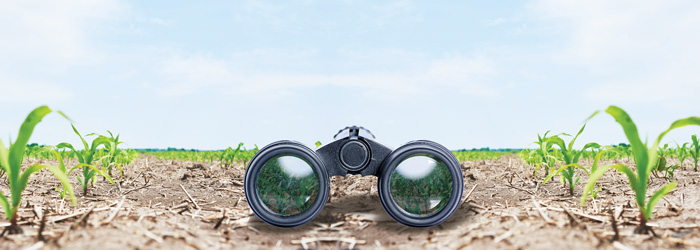April 2023
| JENNY MATHEWS, MANAGEMENT AND DEVELOPMENT SPECIALIST AND EDUCATOR |
 |
Scouting is the process of monitoring crop development in each of your fields. This is done to evaluate crop concerns and economic risks – from germination and emergence issues to identifying potential pests and disease threats. It is a way to examine all aspects of crop production to achieve an optimum yield.
Ideally, farmers should scout their own fields to know first-hand how their crops are performing, rather than leave it to farm workers who visit the fields regularly. Nowadays farmers also rely on experts from extension services and input companies to assist with the field scouting and quickly identify problems. Those experts often have better knowledge, so farmers must not hesitate to phone them and ask for advice.
Why should the spotlight be placed on scouting?
SCOUTING PATTERNS
It is not possible to inspect an entire field, so randomly select enough sample sites within a field to be consistently observed throughout the season. When walking through a field, it is also recommended to have a general scouting plan and walk through the field in either a ‘Z’ or ‘W’ pattern.
PREVIOUS FIELD HISTORY
You should keep history records for each field about the following:
The previous history can be very important when assessing crop problems.
For the current crop year, keep record of the following information:
GETTING STARTED
Field scouting starts before planting. Farmers note the soil moisture and look for signs of common weed populations. This helps to decide if, when and what herbicides to spray for weed control prior to planting.
After planting, scout for crop germination and emergence. Is crop emergence patchy – what conditions are causing patchy emergence conditions? Is the seedbed moisture adequate for germination or is the topsoil hard and crusting in a way that is affecting crop emergence?
During crop germination and emergence, watch for seedling diseases and insects feeding on the roots or emerging leaves.
After full crop emergence, conduct plant stand counts at a minimum number of observation sites. Ask yourself if the target plant population was achieved? What caused the problem? Learn from your observations.
CROP SCOUTING
Weed scouting
Scouting for weeds should start as soon as weeds appear in the field and continue. Scouting fields before planting helps one to plan weed control. Once assessing crop emergence, determine the infestation levels of weeds. With good scouting information, you can select the best herbicides for effective control.
Disease scouting
Scouting for diseases and insect damage can often be done at the same time and includes careful observation of the roots, stems, leaves and seed pods/heads.
If you are unsure of the crop disease, take pictures and send them to your advisor for diagnosis.
Insect scouting
Scouting for insects needs to start at the time of crop emergence. When the population level of an insect nears the threshold level and damage is observed, a rapid decision is needed for optimal control.
Good crop scouting takes some time and effort, but the economic improvement in crop production through good in-season decision-making and improved procedures in the future make it time and effort well spent. It requires a knowledge of crop biology, weeds, insects and diseases. Remember, your field scouting skills will improve as you gain more experience. Seek assistance when you identify issues and need solutions.

Publication: April 2023
Section: Pula/Imvula